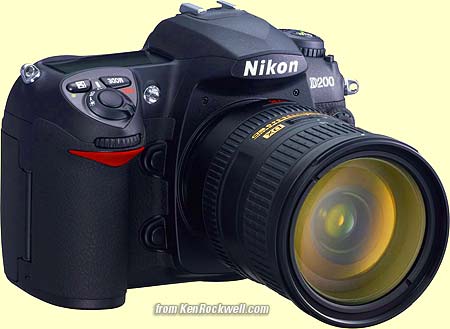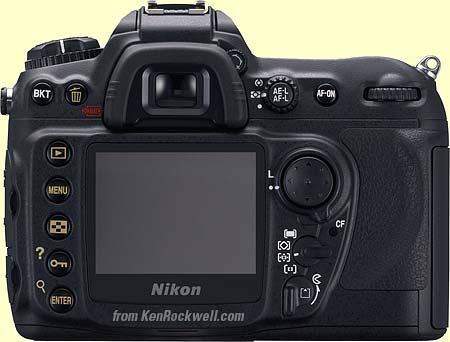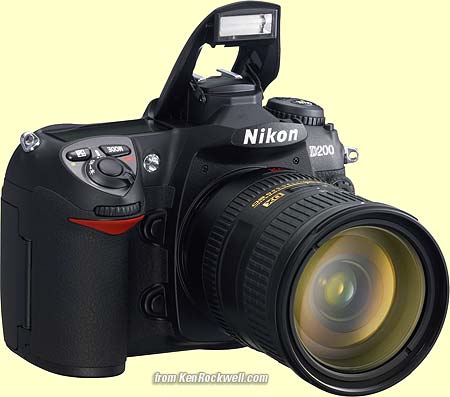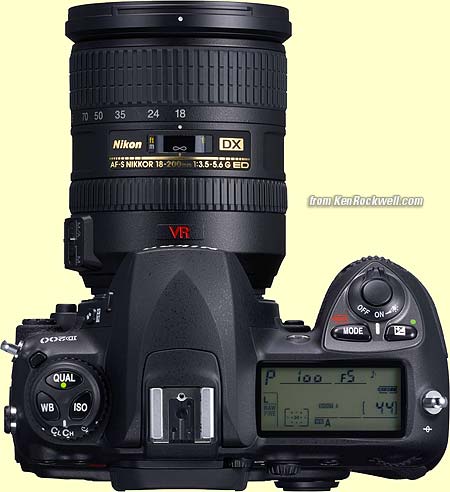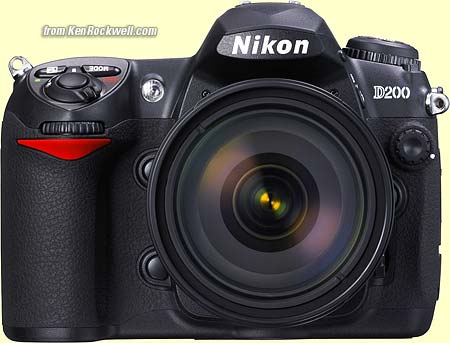© 2005 KenRockwell.com
I just ordered mine from Adorama for $1,699.95 here.
INTRODUCTION
10.2
Megapixels
5 Frames
per Second
2.5"
LCD screen
DX-sized CCD
sensor
11 Area AF system
Rubberized Magnesium Body
$1,699.95
Announced
today, 01 November, 2005
Delivery: End of December,
2005.
Also announced 01 November, 2005: 18 - 200 mm AFS-VR f/3.5 - 5.6G, SU-800 Remote Commander and SB-R200 remote macro flash.
The D200 is Nikon's latest DSLR. It's a semi-pro camera positioned between the hugely popular D70s and the full-time professional D2X. It has absolutely nothing to do with the 3-1/2 year old D100. The D200 is similar in size to the D70 and similar in feel and features to the D2X and adds a built-in flash, which for me is why I ordered a D200 the instant I heard about it.
I expect that this will be the most popular camera used by semi professional photographers due to its light weight, low cost, high speed and tough magnesium body.
Nikon D200. Click to enlarge.
Today I use the D70 and just ordered my D200 from Adorama here. How's that for a camera recommendation? The sooner you get on the list, the sooner you'll get your camera. For my uses the D200 is ideal: I want the best quality without regard to price in the smallest and most convenient package with built-in flash. The D2X is way too big for me. For most normal people (not full-time professional photographers) the D70s and D50 are still my top suggestions, since most people won't use the few extra features I find important.
SPECIFICATIONS
Standard DX size sensor. (23.6 x 15.8 mm).
10.2 Megapixels: 3,872 x 2,592 pixel images. Also 2,896 x 1,944 (M) and 1,936 x 1,296 (S) pixels.
File Formats: JPG, also compressed and uncompressed 12-bit RAW (NEF). RAW + JPG has the ability to store a RAW and a JPG of your choosing. The D70 only could store one kind of JPG in the RAW + JPG setting. You can program the D200 to add up to 36 characters of text to the EXIF header. I add my name, © and phone number to each shot. Once set it keeps adding these to each shot until you tell it otherwise, even if the camera is sold or stolen.
Color Spaces: sRGB (both regular and vivid) and Adobe RGB. This is the same as the D70s. Also adds a black-and-white setting.
ISO: 100 to 1,600, also pushes to 2,000, 2,500 and 3,200! ISOs are settable in full, 1/2 and 1/3 stops. Thank goodness you can set the increments in which ISO is adjusted separately from the increments for other parameters like exposure. Unlike the D70, on the D200 I can adjust ISO in full stops as I prefer and still set exposure in thirds. Whoo hoo! I'm unsure if you can get to the 2,000 - 3,200 ISO directly, or if you have to fumble for them in the menus. The AUTO ISO setting is very flexible, since you can define the shutter speed below which to start increasing the ISO, and the maximum ISO to use. Brilliant.
Frame Rate: 5 FPS
Burst Depth: 37 JPEG (Fine Large) or 22 NEF (RAW). Nikon specs this using a SanDisk SDCFH (Ultra II) or SDCFX (Extreme III) 1GB CF card.
Shutter: 1/8,000 to 30 seconds. Nikon says the shutter is "tested to" 100,000 cycles. This isn't a guarantee from Nikon, just their observation.
Remote release via 10-pin MC-30 or MC-36 There is no built-in IR remote sensor as I prefer on my D70. This is a pain, since the $150 MC-20 I bought for my F100 appears not specified to work on my D200 either. Also remote control via the 802.11b/g WT-3 transmitter.
Mirror Lock-Up: This is a selection on the shooting mode dial on the top left. Press the release once to pop up the mirror, press again to fire the shutter. This is better than nothing, but not as good as most cameras from the 1970s which locked up the mirror automatically at the start of the self-timer operation. MLU is a selection separate from the self timer on the same dial, so you can't get both at the same time.
Nikon D200 with pop-up flash (click to enlarge)
Flash Sync: Only 1/250. Poo.
Built-In Flash: Works with SB-600 and SB-800 for free remote flash control as I explain here. Even better than the D70, the built-in flash of the D200 has the ability to control numerous external flashes simultaneously in three channels (one channel is the built-in flash itself). ISO 100 Guide Number: 40 (feet), 12 (meters), which means like all built-ins it's puny and great for fill.
Flash Control: i-TTL flash control, the same excellent system as the rest of the current Nikon DSLRs. It gives great exposure in just about any crazy condition. PC Sync terminal. FV Lock to lock-in the value of flash exposure from one shot to the next. Auto FP High-Speed Sync is a trick mode to get sync above 1/250. Flash exposure compensation from -3 to +1 stops.
AF Zones: 11. Similar to D2X. Multi-CAM 1000 AF Sensor Module. It has a complex switch on the rear to allow you to select any of one area or multiple sensors to enable Dynamic AF, Closest Subject Priority Dynamic AF and Group Dynamic AF. The Group Dynamic AF uses a subset of the sensors in one area.
AF Mode Selector: the button on the front of the camera lets you select Manual, Single or Continuous directly. The D70 required a menu to get between Single and Continuous.
7-Wide vs. 11-Normal AF areas: You can select to run all the sensors by themselves, in which case you have 11 sensors. You also can set them to look around the image a little more, in which case some of the closer-together sensors' areas overlap, effectively creating the "7-wide" areas to which the Nikon literature refers.
AF Assist Light. The SB-600 and SB-800 also already have illuminators optimized to the 11 AF sensors of the D200.
With new 18 - 200 AFS-VR f/3.5-5.6G lens. Click to enlarge.
Compatible Lenses: Any manual or autofocus Nikon lens made since 1977 works great! This means every Nikon Autofocus lens ever made: AF, AF-n, AF-D, AF-G, AF-S, VR, DX etc. works perfectly. I don't worry about D vs. non-D, even my 20-year old AF lenses give perfect metering on my D70. So long as your manual focus lens is AI or AI-S (which is all lenses since 1977) you'll get metering. If you'll enter some data about your manual focus lens manually you even can get matrix metering with klunky old manual lenses! The D70s and D50 can't use the manual lenses very well at all; they work fine on the D200 as they do on the D2X. I explain this alphabet soup here. Manual lenses lose the Program and Shutter-priority exposure modes, so I stopped using my manual lenses in 1999.
Viewfinder: Huge 0.94x magnification with a 50 mm lens, bigger than just about anything out there. 95% coverage. Everything else is about 0.70 magnification. I'm going to love this, even though I find smaller viewfinders help me compose more powerfully. In addition to all the other things we expect, ISO is also available to see through the finder. I love this, since I reset ISO all the time. Glass pentaprism. -2 to +1 diopter adjustment. No built-in shade as the pro cameras have. There are clever high-priority overlays that indicate B/W mode, low battery or no memory card layered over your subject in the finder.
Gridlines: These are great for keeping horizons horizontal. I always use them, and you can turn them off if they're in your way.
White Balance: Auto, Tungsten, Fluorescent, Daylight, Flash, Cloudy, Shade, White-Card (gray-card) manual and new 2,500º to 10,000º Kelvin preset manual. White balance bracketing of 2 to 9 frames in increments of 1, 2 or 3 of arbitrary Nikon WB tweak units. One NWBTU equals about 10 mireds. I love the new Kelvin adjustment, since it will finally let me get my hands around settings halfway between tungsten and daylight for my indoor interior shots.
Storage: Compact Flash Type I and II and Microdrives
LCD monitor: 2.5," 230,00 pixels. 170 degree viewing angle in all directions, meaning it won't get darker or lighter as you look from below or above like most other LCDs. Magnification only up to 4x, which seems a bit weak considering my Casio EX-Z750 credit-card camera has the same sized LCD and offers up to 8x magnification.
Playback includes 4 or 9 image displays and blinking highlights. I never use these, although the new RGB blinking highlights may be useful.
Useful Histogram: A true RGB histogram allows us to make real exposure judgments. THe single-channel histograms of the D70, D1X, D100 and D50 are useless, since their one channel completely ignores when you clip the red channel, which is what usually overexposes first.
Big Top LCD for reading operating parameters. It seems as huge as the pro cameras. Illumination is easy: just like the pro cameras, flip the power switch to the side against a detent.
Metering: 1,005-pixel 3-D RGB Matrix Metering II. Also variable size center-weighted metering and spot metering at each AF sensor. Personally I always use Matrix.
Exposure Modes: Program, Shutter priority, Aperture priority and Manual. (unconfirmed)
Exposure compensation has a new twist: as always you can set "easy exposure compensation," to save having to press a button to set this with the dial. The D200 adds the ability to tell this to reset itself automatically in case you forget to.
USB 2.0. mini-B connector.
Battery: EN-EL3e, rated 1,800 shots. Battery gauge is in five segments, up from the three of previous cameras. Battery display options add charge percentage, the number of shots made since the last charge and a general indicator of how many more charges you can get out of your battery. That doesn't mean it indicates how many shots you have left. This displays on the rear color LCD; the 5-stage gauge displays on the top LCD. The EN-EL3e looks like it can drop into the D50, D70, D100 and D70s. The older EN-EL3a and EN-EL3 batteries won't work in the D200 since they lack some additional circuitry of the newest EN-EL3e. The "e" in EN-EL3e stands for electronic communications. The EN-EL3e has an electrical capacity of 1,500 mAh, just a little more than the EN-EL3 of the D70 and D50 and the same as the EN-EL3a of the D70s.
Mechanical: Magnesium body and weather seals. This is more like the $5,000 D2X than the plastic D70 I've used for over a year.
Size: 5.9 x 4.4 x 2.9 inches (147 x 113 x 74 mm)
Weight: 29 oz. (830g) stripped: without battery, memory card, body cap, or monitor cover.
Nikon D200. Click to enlarge.
SUPPLIED ACCESSORIES: (may vary by country)
EN-EL3e Battery, MH-18a charger, Video Cable, USB Cable UC-E4, Strap, Body cap, Eyepiece Cap DK-5, Rubber Eyecup DK-21, LCD monitor cover BM-6, PictureProject CD-ROM
OPTIONAL ACCESSORIES:
MB-D200 Vertical Grip takes six AA-size batteries or two EN-EL3e. It adds an additional command dial and alternative buttons for shutter release and AF start for vertical shooting. The AAs may be alkaline, NiMH, lithium or even the crummy "heavy duty" nickel-manganese kind you should avoid.
WT-3 WiFi 802.11b/g Transmitter has buttons for vertical shutter release, AF start and an extra command dial. This transmitter only does all 13 channels, so it's not available in countries that restrict use on some of those channels. I forget which we use in the USA. Nikon says available Spring, 2006.
GPS Adapter Cord MC-35 adds location, elevation and UTC time, along with the usual shooting data, for each image. You also need to provide your own NMEA 0183 (Ver. 2.01) compatible GPS and 9-pin D-sub cable.
C Adapter EH-6.
DK-21M Magnifying Eyepiece.
MC-36 and MC-30 Remote Control Cords.
Nikon also still makes a semi-soft case for it, just like the 1960s.
PERFORMANCE
Resolution: Don't sweat the resolution. Megapixel numbers mean little when comparing cameras. For instance, the 10MP resolution of this D200 translate into images that are 3,872 pixels wide, which isn't that much more than the 6MP D70s' 3,008 pixel wide images. Likewise the 3,872 pixel wide images of the D200 aren't that much less than the 4,288 pixel wide images of the 12MP D2X.
Ergonomics: Superb! You really have to pick up and try the D200 to appreciate it. It's even better than my beloved D70 since the ISO, WB and QUALITY controls have been moved to their own dedicated buttons. The D70, D70s and D50 share these record functions with playback function buttons, so the older cameras required you to tap the shutter button to get the camera back to the shooting mode before hitting them, otherwise you'd tweak a playback function by accident instead of your ISO. The D200 is brilliant!
New Function Button: The D200 adds a special programmable function button just below the depth-of-field preview button. You can use this to give you instant access to the feature of your choice, which ought to make swapping between banks of presets a breeze. You can preset this button to do any oner of: turning off the flash, locking the flash exposure, changing exposure in full stops, duplicating the AF-L/AE-L button, shooting a bunch of brackets, changing to Spot, Center or Matrix metering modes, and more. of course you only get one of these functions at a time, set in a menu.
Aliasing (also called Moiré): These areor those weird color bars seen on fine repeating textures. Nikon claims to have fixed the aliasing (Moiré) problem of the D70.
New JPG compression option: You can ignore this, but I've always whined that some brands, like Nikon and Casio, create almost the same size JPG files regardless of image complexity. This means I have to crank up the quality setting by hand for complex images to maintain the same quality. Other brands like Canon and Sony compress JPGs so that the quality remains constant regardless of image complexity, which I prefer. Canon and Sony JPG files will vary wildly in size depending on the image. A world's first for the D200 is the choice between these two systems. Nikon calls the constant file size option it's always used "Size Priority," and the method used by Canon and Sony which I prefer as "Optimal Quality." I'm setting mine to "Optimal Quality." This saves me from wanting to tweak the JPG quality setting for different subjects, but will make it almost impossible for you to predict how many shots you'll get on a card with any accuracy.
Noise Reduction Options: You can turn these all off and on as you prefer. In addition to the usual cumbersome dark-frame subtraction for long exposures, you can control the nature of the grain reduction applied to the images made at ISO of 400 and above. You can control how much grain reduction happens, or turn it off entirely. I have to test how well this works versus doing it with my favorite degraining tools in Photoshop.
TRICKS
Four Shooting Setting memories: This will be immensely helpful for the fast shooting I do. They are called out as A, B, C, and D on the top LCD, and you can name them when displayed on the rear color LCD.
Four Custom Settings memories A, B, C, and D. This will be immensely helpful for the fast shooting I do, however the fact that I see different banks for Shooting and for Custom means that Nikon may still not have this right. You should only have to change one setting in an ideal camera to go between your high ISO, indoor setting and your setting for outdoor sports, for instance. On previous Nikons like my D1H the user setting banks recalled some of the settings, but not all. Thus the banks saved some time but were still not as elegant and all encompassing as those on my Casio EX-Z750 pocket camera.
Recent Settings List displays the last 14 settings you changed. This is very helpful to allow you to call up whatever weird settings you're playing with at the moment. For instance, if you changed some obtuse setting like contrast and then a basic one like ISO, you can get right back to the contrast setting without having to dig it out in the menus again.
40 custom functions, similar to D2X.
Intervalometer: You tell the D200 when to start shooting (or have it start now), how often to shoot, and how many shots to make. This lets you shoot time-lapse sequences without having to be there. I'm going to use it to document the way the light and clouds change over the course of a day. Intervalometers used cost thousands of dollars as stand-alone boxes back in the 1970s, and today it's just free firmware inside the D200.
Multiple exposures up to 10.
Image overlays with RAW NEF images. This lets you combine two images onto each other with varying transparency. I prefer to do this in Photoshop when I'm sitting down, thank you.
World time clock. Easy swapping between daylight time without having to reset anything.
COMPARED TO CANON
The D200 trumps the Canon 20D in spades, and every time Nikon announces something Canon one-ups them the next week. Canon is overdue for the replacement for the 20D. Even crazier, the D200 trumps the $3,200 Canon 5D for its superior durability and speed and ease of use.
MORE INFORMATION
Here's the D200's English press release from Japan.

